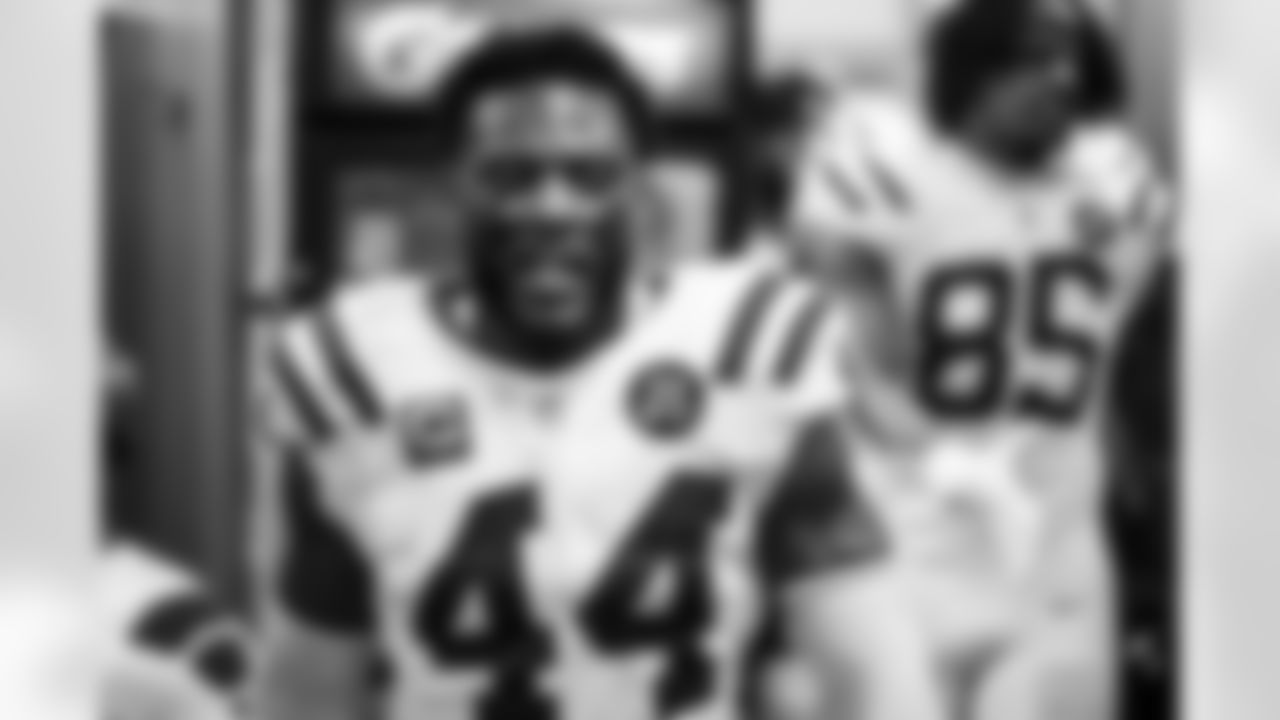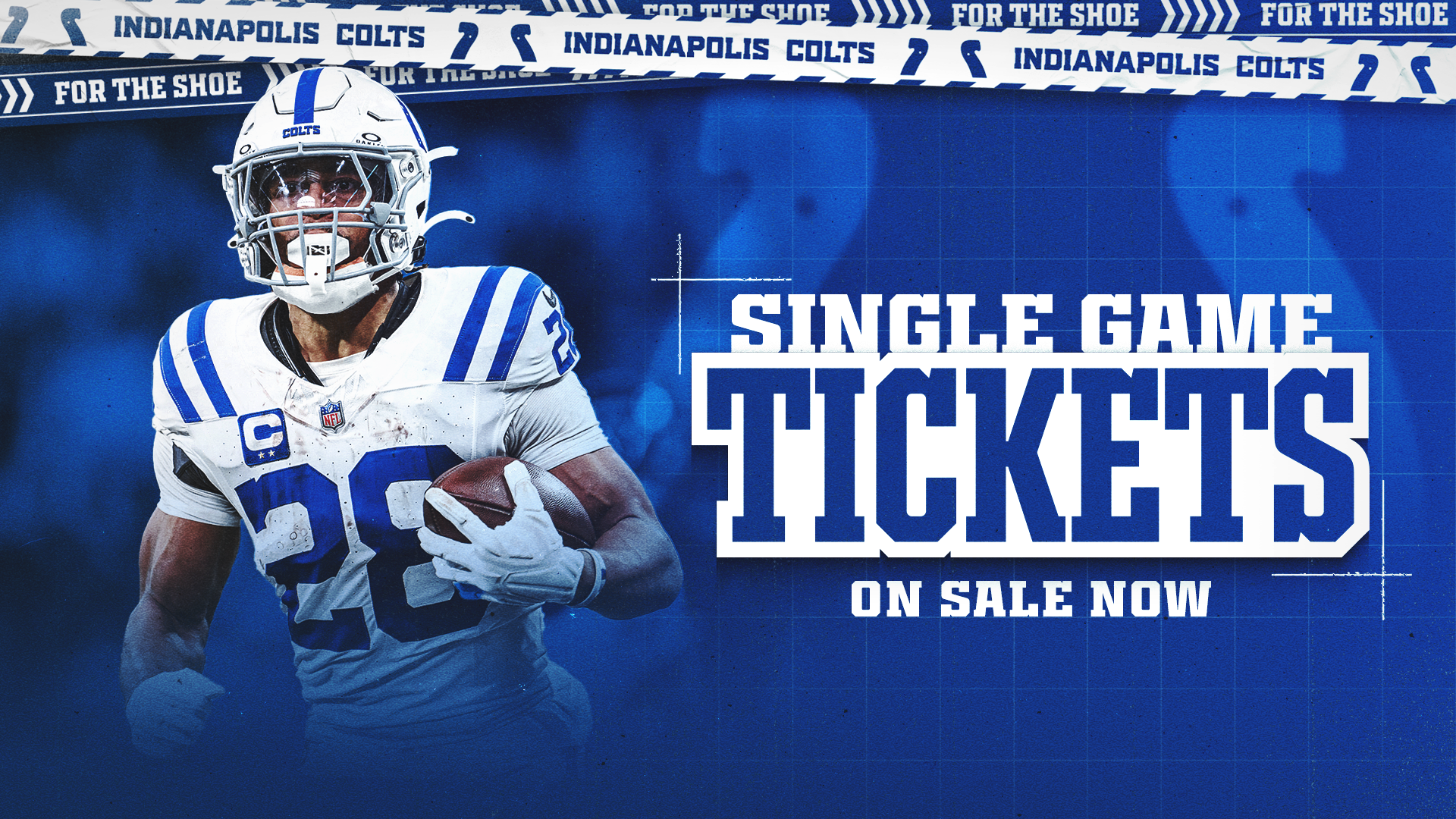1. Daniel Jones' ability to avoid sacks has been a major driver of the Colts' offensive success.
The Colts are the first team since at least 1940 to punt just one time in their first three games of a season – and that remarkable stat is, through one lens, the product of quarterback Daniel Jones being sacked just two times this season.
Sacks are notorious drive killers, which makes sense – the offense loses significant yardage and winds up in difficult down-and-distances, while the defense gets a momentum boost and can be in attack mode on second- or third-and-long. Just look at the difference in the end result of drives this season (not including Monday Night Football) when an offense takes a sack or not:
| Drive type | Score % | Touchdown % | Punt % |
|---|---|---|---|
| No sacks | 40.5% | 22.7% | 34.8% |
| 1+ sack | 28.3% | 13.2% | 52.5% |
Or, here's another way to think about how sacks impact things:
| Play type | EPA/play (2025 season) |
|---|---|
| All dropbacks | +0.018 |
| Sack | -1.887 |
| Pass attempt | +0.165 |
| Scramble | +0.428 |
"When you look at a lot of the statistics and how you evaluate likelihood of scoring, I think those negative plays are huge, drive killers and having just one of them in a drive can really hurt your chances," Jones said. "So I think we've been doing a good job with that. Got to give big credit to the guys up front. The offensive line, obviously, that's where it starts. And then guys getting open and my job to get the ball out on time. So, I think that's everybody working together, but starts up front for sure."
Against the Titans, Jones was under pressure on just seven of his 27 dropbacks – and none of those dropbacks under pressure came in the second half, for what it's worth. He did not get sacked on those seven dropbacks, and through three games, he has the lowest pressure-to-sack ratio in the NFL (not including Monday Night Football):
| QB | Team | Dropbacks under pressure | Sacks taken | Pressure to sack % |
|---|---|---|---|---|
| Daniel Jones | IND | 34 | 2 | 5.9% |
| Brock Purdy | SF | 17 | 1 | 5.9% |
| Sam Darnold | SEA | 30 | 3 | 10% |
| Dak Prescott | DAL | 50 | 5 | 10% |
| Bo Nix | DEN | 28 | 3 | 10.7% |
Prior to joining the Colts, Jones was sacked 208 times on 1,051 dropbacks under pressure with the New York Giants (2019-2024), per Pro Football Focus, equaling a pressure-to-sack ratio of 19.8 percent. But this is where situation matters: Over the last two seasons, Pro Football Focus tagged the Giants with 499 pressures allowed, second-most in the NFL behind only the Seattle Seahawks (500).
In 2025, the Colts have allowed the eighth-lowest pressure rate (25.8 percent) in the NFL.
So Jones is under pressure less than he's ever been, but when he has been pressured, he's not taking sacks. The most impressive play he had against the Titans came on a third-and-seven at the Tennessee 42-yard line late in the first quarter: As Jones hit the back of his drop, defensive tackle Jeffrey Simmons crashed into the pocket and lunged at the Colts quarterback. Jones spun away from Simmons to his left, quickly re-gained his balance, put his foot in the ground and accelerated into open space, dashing all the way to the Titans' 25-yard line for a gain of 17.
If Jones takes a sack there, the Colts punt. Instead, a few plays later, running back Jonathan Taylor plunged into the end zone for a one-yard touchdown that put the Colts up 17-3.
"That third down right there around midfield was big because we were kind of on the edge of field-goal range, and obviously we're trying to get it there and they brought some pressure there for him to get out of there and scramble for the first down was a huge play for us there," head coach Shane Steichen said. "I think he's just seeing it really well. He's seeing it really well, getting us in and out of the right plays, delivering the ball with accuracy. He's playing really good right now."
2. Tyler Warren's best play came without the ball in his hands.
Taylor was able to spring into the second level – where he broke three tackles – on his 46-yard touchdown run because of the block thrown by tight end Tyler Warren, who was lined up as a fullback on the play.
This might as well have been a highlight straight out of 1985, not 2025, with Warren putting his hand in the dirt offset to the left of Taylor. At the snap, left tackle Bernhard Raimann and tight end Mo Alie-Cox clear out the C-gap (between the tackle and tight end), which Warren flows through toward linebacker Cody Barton. Warren throws his right shoulder into Barton, knocking him off balance and well out of the way of Taylor, who then has plenty of space to set up a juke and a spin before shedding a tackle and accelerating toward the end zone.
Steichen after the game highlighted Warren's block to set up this "smashmouth" classic iso run.
"He's just an old school throwback freaking baller," Steichen said. "The toughness, the grittiness that he plays with, it's awesome. He's a blue-collar player, do anything for the team, and just does the job at a high level."
Through his first three NFL games, Warren has – these numbers are per Pro Football Focus – lined up nine times in the backfield, 94 times as an in-line tight end, 31 times in the slot and 24 times out wide. This is nothing new for Warren, who at Penn State threw a pass while lined up at quarterback and caught a touchdown after snapping the ball as a center (both as part of his 19-catch game against USC).
But it's one thing to do play all those different positions in college; it's another in your first three games in the NFL. The mental load it takes to do all those additional things while still being a factor in the passing game – Warren had three catches for 38 yards – is significant. Warren, though, has handled all that extremely well, whether he's lined up as a tight end, a wide receiver or, like on Sunday, a fullback.
"For him to be able to execute it like that — that's big time, especially asking a rookie to do that," Taylor said.
3. The Colts again were able to succeed on offense through versatility, and there's a sneaky undercurrent to that.
Think about the different skillsets of Warren, Michael Pittman Jr., Josh Downs, Alec Pierce and Adonai Mitchell – each has strengths of their game and is able to attack different areas of the field in different ways. Those guys have, so far, meshed together awfully well within the Colts' offense.
But there's one trait that group, collectively, shares: An unselfish, physical willingness to block on running plays. That's something offensive coordinator Jim Bob Cooter pointed to earlier this month as he discussed how the skillsets of those pass-catchers work together.
"Sometimes you have (varying receiving skillsets), but the guys are unable to help in the run game whether that be not being very good blockers or not very willing blockers," Cooter said. "We're lucky enough to have guys that are willing and they work at blocking in the run game. So now you combine sort of that multiplicity of threats in the pass game with a really good running game that you can do different things with different guys in. Now you really got a shot."
On Taylor's 46-yard run, he got an assist downfield from Pittman, who got hands on cornerback L'Jarius Sneed as Taylor sprinted toward the end zone. Earlier in the game, the Colts lined PIttman up in the slot, where he blocked cornerback Roger McCreary to create a hole just big enough for Taylor to slip through for a 12-yard gain midway through the second quarter.
Against the Broncos, Pittman helped spring a couple of explosive runs – including Taylor's 68-yard dash – with some physical blocks, while wide receiver Ashton Dulin thumped cornerback Pat Surtain II as part of a 10+ yard Taylor rush.
The point here is the Colts aren't giving opposing defenses a tell based on the personnel they have on the field. They can run the ball out of 11 personnel (three wide receivers, one running back, one tight end) as well as they can pass it. The presence of a certain wide receiver or tight end on the field is not an indication of if a run or a pass is coming. And the trust the Colts have in their skill personnel to do both – catch or block – has allowed the versatility of this offense to flourish.
"A lot of these runs, they become explosive because of them," Taylor said of the Colts' wide receivers. "But I always feel like you get rewarded because then, at the end fo the day, when they go and sell out for the run, now these guys get their one-on-one matchups. I think it's a testament to their level of unselfishness to go out there, put their bodies on the line for the run game."
4. The Colts' defense kept a lid on the Titans' offense.
Six of the Titans' nine drives ended with a touchdown or a field goal attempt, but the Colts defense did what it had to given the circumstances of Sunday's game. After cornerback Kenny Moore II's pick six three plays into the game, the Colts had control of things, and defensively they worked to not let the Titans back into the game by keeping a lid on explosive plays down the field.
While quarterback Cam Ward did complete passes of 27 and 22 yards, he finished the afternoon with an average of just 5.8 yards on his 38 pass attempts. Ward attempted just one pass that traveled more than 20 yards beyond the line of scrimmage
Running back Tony Pollard averaged 2.8 yards per carry on 16 attempts, too, as the Titans weren't able to spring much on the ground.
The point here is the Colts clamped down on the Titans early, with a long field goal and a three-and-out following Moore's pick-six, and then used the clock and the scoreboard to their advantage the rest of the game. The Colts had a 17-3 lead after the first quarter and lead 20-6 at halftime, and held on to that two-score advantage for the entire second half.
With that in mind, as the Titans tried to mount a comeback, they only had three possessions in the second half. While two ended in touchdowns, those took a combined 13 minutes and 47 seconds off the clock – not the kind of quick-strike drives a team chasing a 14-point deficit needs.
5. Rigoberto Sanchez wasn't rusty at all.
Every stat anyone has pulled about the Colts not punting until the second quarter of Week 3 is fascinating, like this latest one. But if you're only going to have one punt on the season, you might as well make it count – and Sanchez booted a 46-yarder from the Colts' 45-yard line that was fair caught at the Titans' nine-yard line.
"We even got a punt in today, so congratulations to Rigo," linebacker Zaire Franklin grinned.
Since we're here, the NFL record for fewest punts in a season (1945-2024, using Pro Football Reference's Stathead) is 23, set by the 1982 San Diego Chargers – but just nine regular season games were played that season due to a work stoppage. The fewest punts in a 16-game season is 34, set by the 1990 Houston Oilers; for a 17-game season, the 2021 Kansas City Chiefs punted just 40 times.
And in the Super Bowl era, the list of the teams with the fewest punts in the first three games of a season is:
| Team | Year | # of punts |
|---|---|---|
| Indianapolis Colts | 2025 | 1 |
| Washington Commanders | 2024 | 3 |
| San Francisco 49ers | 1992 | 3 |
| Buffalo Bills | 2022 | 4 |
| New England Patriots | 2007 | 4 |
| San Francisco 49ers | 1993 | 4 |
Notable here: The other five teams on that list all made the playoffs.
View photos from the Colts locker room following the team's 41-20 victory over the Tennessee Titans in Week 3!


QB Daniel Jones #17

RB Tyler Goodson #31

DL Kwity Paye #51

G Matt Goncalves #71 and C Danny Pinter #63

G Matt Goncalves #71, C Danny Pinter #63 and G Dalton Tucker #68

TE Mo Alie-Cox #81

T Braden Smith #72 and OL Quenton Nelson #56


T Braden Smith #72 and T Luke Tenuta #67

LB Cameron McGrone #59

Kalen Jackson Owner & Chief Brand Officer and President of the Indianapolis Colts Foundation

CB Jonathan Edwards #35

TE Drew Ogletree #85

LB Zaire Franklin #44

QB Anthony Richardson #5 and TE Tyler Warren #84

QB Anthony Richardson #5 and TE Tyler Warren #84

DE Tyquan Lewis #94


Kalen Jackson Owner & Chief Brand Officer and President of the Indianapolis Colts Foundation and Carlie Irsay-Gordon Owner & CEO

Shane Steichen Head Coach

Kalen Jackson Owner & Chief Brand Officer and President of the Indianapolis Colts Foundation and Carlie Irsay-Gordon Owner & CEO

Kalen Jackson Owner & Chief Brand Officer and President of the Indianapolis Colts Foundation and Carlie Irsay-Gordon Owner & CEO

T Jalen Travis #75

T Bernhard Raimann #79

T Bernhard Raimann #79

OL Bernhard Raimann #79, QB Anthony Richardson #5 and Chris Watt Assistant Offensive Line

QB Daniel Jones #17 and WR Alec Pierce #14

QB Daniel Jones #17 and WR Alec Pierce #14

QB Daniel Jones #17 and WR Alec Pierce #14

TE Tyler Warren #84 and TE Drew Ogletree #85

RB Jonathan Taylor #28

QB Daniel Jones #17

QB Daniel Jones #17

QB Anthony Richardson #5

S Daniel Scott #36

QB Daniel Jones #17

T Bernhard Raimann #79 and G Tanor Bortolini #60

OL Bernhard Raimann #79 and G Tanor Bortolini #60

Kalen Jackson Owner & Chief Brand Officer and President of the Indianapolis Colts Foundation and Carlie Irsay-Gordon Owner & CEO

Kalen Jackson Owner & Chief Brand Officer and President of the Indianapolis Colts Foundation and Carlie Irsay-Gordon Owner & CEO

TE Drew Ogletree #85

James Bettcher Linebackers, Tony Sparano Jr. Offensive Line, OL Bernhard Raimann #79, Chris Watt Assistant Offensive Line, G Tanor Bortolini #60, T Luke Tenuta #67, C Danny Pinter #63 and G Dalton Tucker #68

G Matt Goncalves #71, C Danny Pinter #63 and G Dalton Tucker #68

G Dalton Tucker #68

QB Daniel Jones #17

T Braden Smith #72 and QB Daniel Jones #17

Carlie Irsay-Gordon Owner & CEO, Kalen Jackson Owner & Chief Brand Officer and President of the Indianapolis Colts Foundation and Casey Foyt Owner & Executive Vice President

Carlie Irsay-Gordon Owner & CEO, DE Tyquan Lewis #94, Kalen Jackson Owner & Chief Brand Officer and President of the Indianapolis Colts Foundation and Casey Foyt Owner & Executive Vice President

LB Zaire Franklin #44 and LB Segun Olubi #50

TE Drew Ogletree #85

Shane Steichen Head Coach

Shane Steichen Head Coach

Shane Steichen Head Coach

Shane Steichen Head Coach

Shane Steichen Head Coach

Shane Steichen Head Coach

TE Tyler Warren #84

DE Samson Ebukam #52, Kalen Jackson Owner & Chief Brand Officer and President of the Indianapolis Colts Foundation, Carlie Irsay-Gordon Owner & CEO, DT Grover Stewart #90, DT Eric Johnson II #98, DE Tyquan Lewis #94 and DT Neville Gallimore #92

G Dalton Tucker #68, RB Jonathan Taylor #28, RB DJ Giddens #21, RB Tyler Goodson #31, QB Anthony Richardson #5 and QB Daniel Jones #17

LB Austin Ajiake #58, LB Zaire Franklin #44, LB Segun Olubi #50, Shane Steichen Head Coach, Cato June Assistant Linebackers and DE Samson Ebukam #52

LB Segun Olubi #50, CB Jonathan Edwards #35, Shane Steichen Head Coach, DE Samson Ebukam #52, Kalen Jackson Owner & Chief Brand Officer and President of the Indianapolis Colts Foundation, Carlie Irsay-Gordon Owner & CEO and DT Grover Stewart #90

DE Samson Ebukam #52, Kalen Jackson Owner & Chief Brand Officer and President of the Indianapolis Colts Foundation, David Thornton Vice President of Team Engagement, Carlie Irsay-Gordon Owner & CEO, DT Grover Stewart #90, CB Kenny Moore II #23, DT Eric Johnson II #98, DT Neville Gallimore #92 and DE JT Tuimoloau #91

CB Jonathan Edwards #35, Cato June Assistant Linebackers, Shane Steichen Head Coach, DE Samson Ebukam #52, Kalen Jackson Owner & Chief Brand Officer and President of the Indianapolis Colts Foundation, David Thornton Vice President of Team Engagement, CB Kenny Moore II #23, Carlie Irsay-Gordon Owner & CEO, DT Grover Stewart #90 and DE Tyquan Lewis #94

CB Jonathan Edwards #35, Cato June Assistant Linebackers, Shane Steichen Head Coach, CB Kenny Moore II #23, Carlie Irsay-Gordon Owner & CEO, DT Grover Stewart #90 and DE Tyquan Lewis #94

G Quenton Nelson #56, LB Austin Ajiake #58, CB Kenny Moore II #23, DT Neville Gallimore #92 and DT Eric Johnson II #98

G Tanor Bortolini #60 and DT Neville Gallimore #92

RB Jonathan Taylor #28















